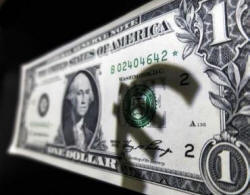|
 Euro
sinks to 12-year lows as yield gap grows Euro
sinks to 12-year lows as yield gap grows
 Send a link to a friend
Send a link to a friend
[March 11, 2015]
By Patrick Graham
LONDON (Reuters) - The euro dived to its
lowest since early 2003 against the dollar on Wednesday, dragging other
European currencies with it on the back of the huge differences
developing in market interest rates between Europe and the United
States.
|
|
 In a dollar rally that began last July the single currency has lost
around a quarter of its value, and there is little sign of that
bottoming out. Deutsche Bank on Tuesday forecast a fall to 85 U.S.
cents by the end of 2017. In a dollar rally that began last July the single currency has lost
around a quarter of its value, and there is little sign of that
bottoming out. Deutsche Bank on Tuesday forecast a fall to 85 U.S.
cents by the end of 2017.
That comes largely courtesy of the collapse in European bond yields,
which are set to stay low for the foreseeable future under the
program of money-printing launched by the European Central Bank on
Monday. Yields on German 30-year government bonds are now lower than
those on U.S. two-year paper.
The picture for European stock markets, given the projected 1
trillion of new euros set to flow into the financial sector, is less
grim, and the main indexes were all higher in early trade.
"It's the euro versus everything," said Stephen Gallo, European head
of FX strategy at BMO Capital Markets in London. "The way these
moves look, it's not just speculators piling into euro shorts, it's
actually net flow of capital out of the euro."

"There's a pick-up in Eurosystem excess liquidity just as the Fed is
playing with its own operations to try to withdraw liquidity and as
the rhetoric is tilted towards rate hikes."
The euro sank as low as $1.0638 in early European deals, its weakest
since 2003. The Norwegian and Danish crowns both hit similar lows
and the Swedish crown a six-year low.
There is little optimism to be found in Asia, where poor data out of
China helped stock markets fall to two-month lows.
MSCI's broadest index of Asia-Pacific shares outside Japan was down
0.4 percent after touching its lowest since January. Australian
shares lost 0.5 percent and Malaysian and Indonesian stocks also
declined.
The falls there and on Wall Street overnight contrasted with gains
of around 1 percent in Europe, pointing to the impact of the ECB's
quantitative easing program.
[to top of second column] |

"It is remarkable... that European equities like the DAX are still
materially cheaper than US equities and still down versus last
summer in dollar terms," said BNP Paribas head of global equities
and derivatives strategy Gerry Fowler.
"I suspect that in another six months the market may look back and
think that a further 20 percent rally (and outperformance) in
European equities should not have been considered all that unlikely
under the circumstances."
Japan's Nikkei added 0.3 percent as better-than-expected machinery
orders helped offset Wall Street losses.
But the deepening decline in the yen, usually a positive factor for
Japanese stocks as it buoys exporters, led some to worry about other
consequences like the burden placed on importers.
"The market started to worry about side-effects from a further slide
in the yen," said Hiroichi Nishi, general manager at SMBC Nikko
Securities in Tokyo, adding that there are also concerns that a
stronger dollar hurts U.S. multinational companies' earnings.
(Additional reporting by Ayai Tomisawa and Shinichi Saoshiro in
Tokyo; Jemima Kelly, Jamie McGeever and Anirban Nag in London;
Editing by Hugh Lawson)
[© 2015 Thomson Reuters. All rights
reserved.] Copyright 2015 Reuters. All rights reserved. This material may not be published,
broadcast, rewritten or redistributed.
 |